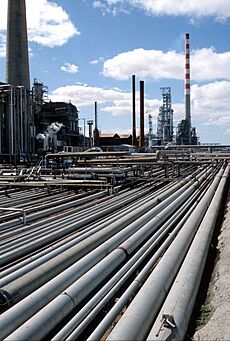Corio, Victoria facts for kids
Quick facts for kids CorioGeelong, Victoria |
|||||||||||||||
|---|---|---|---|---|---|---|---|---|---|---|---|---|---|---|---|
| Population | 15,296 (2016 census) | ||||||||||||||
| • Density | 1,214/km2 (3,140/sq mi) | ||||||||||||||
| Established | 1860s | ||||||||||||||
| Postcode(s) | 3214 | ||||||||||||||
| Elevation | 17 m (56 ft) | ||||||||||||||
| Area | 12.6 km2 (4.9 sq mi) | ||||||||||||||
| Location | |||||||||||||||
| LGA(s) | City of Greater Geelong | ||||||||||||||
| State electorate(s) | Lara | ||||||||||||||
| Federal Division(s) | Corio | ||||||||||||||
|
|||||||||||||||
Corio is a busy area in Geelong, Victoria, Australia. It has both homes and factories. Corio is one of the biggest suburbs in Geelong. It is about 9 km north of Geelong's city centre. The area used to be called Cowie's Creek. This name came from James Cowie, an early landowner.
Contents
History of Corio
Early Days and Naming
Explorers Hume and Hovell visited Corio a long time ago. They learned that the local Aboriginal people called the area 'coraiyo'. This word might have meant 'small marsupial' or 'sandy cliffs'.
In 1852, land in the area was first divided up and sold. It was called "Cowie's Creek" back then. By the 1860s, about 500 people lived in Cowie's Creek. There were also two hotels.
Post Offices and Schools
A post office opened on 16 November 1864. It was on School Road. In 1913, its name changed to Corio Post Office. Later, in 1963, it became Corio North Post Office. This happened when a new Corio Post Office opened at the Corio Shopping Centre. The Corio North Post Office closed in 1977.
In 1914, the famous Geelong Grammar School moved to its current spot. This new location is near Limeburners Lagoon, which is part of Corio Bay.
Shopping and Growth
The Corio Village Shopping Centre opened in 1973. It has many popular stores like K-Mart, Coles, and Woolworths. You can also find places to eat like McDonald's and Subway. There are banks and government offices too. After some upgrades in 2007/08, it became known as the Corio Shopping Centre.
More shops have opened in Corio over the years. The Aldi supermarket built a store near Beckley Park. Other shops like Harvey Norman also opened along the Princes Highway.
Industry in Corio
One of the most important industries in Corio is the Geelong Oil Refinery. This refinery started in 1956. It was first owned by Shell Australia. In 2014, a company called Vitol bought the refinery. They now call their Australian business Viva Energy.
Getting Around Corio
Most people in Corio use cars to get around. There are also buses run by CDC Geelong. These buses connect different parts of Corio to the Geelong city centre. You can also use taxis and ridesharing services.
The Corio railway station has trains that go to Geelong and Melbourne. In 2009, the Geelong Bypass opened. This means that cars traveling through Corio on the Princes Freeway now go around the suburb.
Sports and Clubs
Corio has many sports clubs for young people and adults.
- Geelong SC is a soccer club started in 1958. They play at Stead Park.
- An Australian rules football team was formed in 1974. They play in the Geelong & District Football League.
- The Corio Sporting Club also has a cricket club and a netball club.
- The Corio Athletic Club started in 1969. They compete at Landy Field in South Geelong.
- The Corio Little Athletics Club began in 1967. They train at the Corio Athletics Stadium. This stadium was opened in 1972 by famous runner Ron Clarke.
Corio's People
Population Facts
The 2016 census counted 15,296 people living in Corio.
- About half of the people were male (49.2%) and half were female (50.8%).
- The average age of people in Corio was 35 years old.
- About 2.0% of the people were Aboriginal and Torres Strait Islander.
- Most people (68.3%) were born in Australia. Other countries where people were born include England (3.1%), Afghanistan (1.9%), and Myanmar (1.8%).
- Most people (74.6%) spoke only English at home. Other languages spoken include Karen (3.1%), Hazaraghi (1.3%), and Dari (1.1%).
- For religion, many people said No Religion (34.4%), Catholic (21.6%), or Anglican (10.6%).
Jobs and Work
Corio is a place where many people work in hands-on jobs. About 22.4% of employed people aged 15 and over worked as 'Labourers'. This means they often do physical work or operate machines. This number is higher than the average for all of Australia. Many people also work as technicians, trades workers, or machinery operators.
In 2016, the closure of the Ford car plant affected jobs in Corio. The Ford Motor Company had a factory there for a long time. It started making cars in 1926. During World War II, Ford made military vehicles. After the war, they focused on making engines for the Ford Falcon car.
In 2016, 5,855 people aged 15 and over were working or looking for work. About 49.7% worked full-time, and 31.7% worked part-time.
The average price for a house in Corio in September 2012 was $223,000. This made it one of the more affordable places to live in Victoria.



